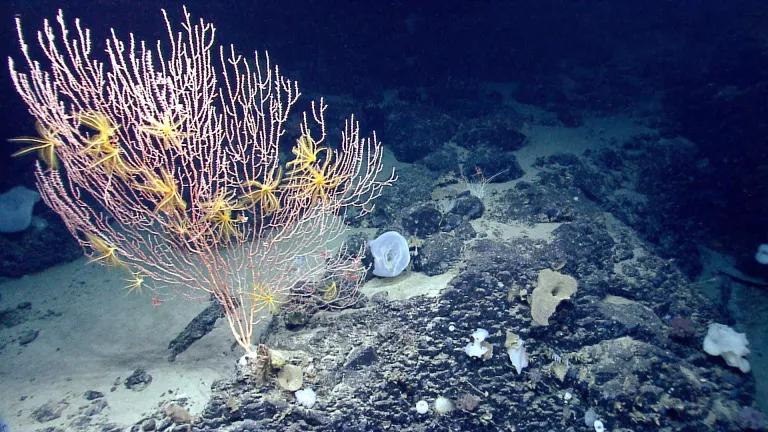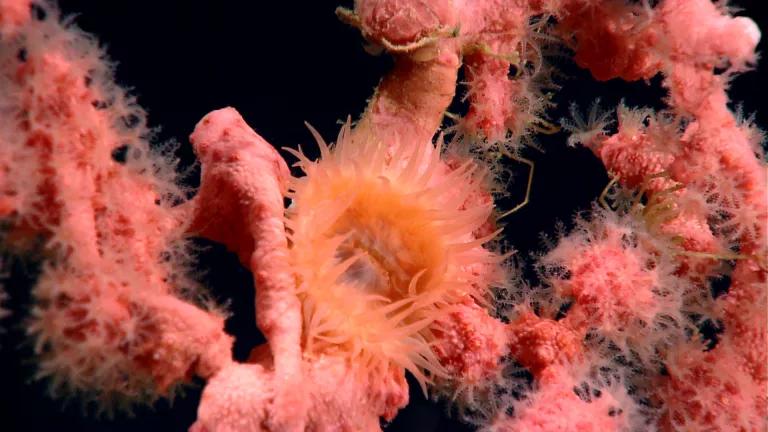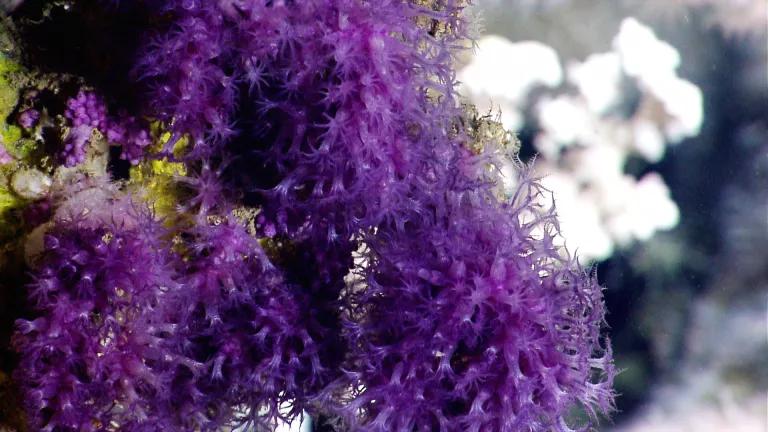What It Took to Create the Atlantic’s First Marine National Monument
After years of work by NRDC and its partners, about 5,000 square miles of ocean—with massive canyons, majestic underwater mountains, and more than 1,000 species—have received permanent protection.

A colony of bamboo coral found during the Northeast U.S. Canyons Expedition 2013
UPDATE: On March 22, 2021 the U.S. Supreme Court let stand a lower court ruling that upheld the legality of the Northeast Canyons and Seamounts Marine National Monument. It declined to hear a case brought by the commercial fishing industry challenging the president’s authority to create marine monuments.
In the summer of 2013, a remotely operated vehicle (ROV) named Deep Discoverer made its maiden voyage, diving 6,000 meters into cold ocean waters off New England to explore a section of the Atlantic, some parts of which previously hadn’t been visited by humans. The photos, videos, and real-time footage that the ROV captured—viewable by anyone with an Internet connection—depicted a wild landscape of rugged canyons and soaring mountains (called seamounts) teeming with centuries-old coral, giant fish, and never-before-seen species. These images, shared by the National Oceanic and Atmospheric Administration, demonstrated to the world that this bit of the Atlantic was an ecological hot spot, a veritable underwater Serengeti. Three years later, in September 2016, President Obama designated three of these canyons and the area’s four seamounts—a 4,913-square-mile area about 150 miles off the coast of Cape Cod—as the Northeast Canyons and Seamounts Marine National Monument.
NRDC’s interest in this now-protected seascape dates back a decade and a half, to when a group of scientists gathered at NRDC’s New York office to identify priority areas for protection in the region. The canyons, rivaling the Grand Canyon in depth, and the underwater mountains, towering higher than anything east of the Rockies, “lit up as areas for protection,” says Brad Sewell, who oversees NRDC’s work on fisheries and Atlantic Coast ocean issues. “These spectacular ocean features and the unique wildlife they sustain were identified by scientists as biodiversity gems.” Moreover, the seamounts are the only ones in U.S. Atlantic waters.

Ecological gems or not, it isn’t easy to advocate for the protection of a place that’s entirely out of the general public’s view. “It can be difficult to protect the ocean because you can’t see what’s beneath the surface,” Sewell says. “It’s easy to dismiss it. It’s easy to ignore.” Deep Discoverer’s dramatic footage, however, was visual proof of the area’s magnificence and went a long way toward creating buzz about it. “That experience and that exploration helped catalyze a number of groups and broader interest,” Sewell says.
A year after Deep Discoverer’s dive, NRDC began an effort to permanently protect the area. The Conservation Law Foundation, Pew Charitable Trusts, the Mystic and New England aquariums, Earthjustice, and a handful of other organizations were partners in the effort and started to build a diverse coalition aimed at turning the canyons and seamounts into a national monument. Supporters eventually included elected officials, business leaders, scientists, faith-based groups, fishermen, marine mammal research groups, whale watch operators, dive groups, and more than 300,000 members of the public. Connecticut Senator Richard Blumenthal and the Connecticut congressional delegation, recognizing the special and deserving nature of the area, sent a letter to the president asking that the canyons and seamounts be permanently protected as a marine national monument.
The timing was ideal. The ecosystem of the region―“one of the least fished areas in the North Atlantic because it’s deep, rugged, and far from shore,” Sewell says―was still largely intact. Only permanent protections, however, could preserve its ecological integrity, safeguarding against potential threats like oil and gas drilling, deep-sea mining, and expanded commercial fishing and helping the region withstand looming dangers like ocean acidification and climate change. “We need whole systems healthy and intact so they can rebound as they face these new challenges,” says Alexandra Adams, an NRDC senior ocean advocate.

With NRDC as one of the leaders, a major effort was undertaken to collect data about the scientific value of the region and potential threats, translate the information into relatable terms, and put it in front of influential decision makers as well as the public. “We made the complex science clear and allowed citizens to engage and really understand what we were hoping would be protected,” Adams says. Over two years, NRDC played a major role in that outreach.
These efforts paid off on September 15, when President Obama, speaking at the Our Ocean conference in Washington, D.C., designated the Northeast Canyons and Seamounts Marine National Monument—the first such monument off the continental United States. Addressing the importance of ocean conservation, the president said, “Dangerous changes in our climate, caused mainly by human activity; dead zones in our ocean, caused mainly by pollution that we create here on land; unsustainable fishing practices; unprotected marine areas, in which rare species and entire ecosystems are at risk—all those things are happening now. They’ve been happening for a long time. So if we’re going to leave our children with oceans like the ones that were left to us, then we’re going to have to act. And we’re going to have to act boldly.”
Adams will never forget that moment. “It was an overwhelming and humbling experience,” she says. “I was overtaken with pride in our country’s commitment to protect its most precious ocean areas. And realizing that a rare and special piece of the Atlantic would thrive forever was incredible.”
This NRDC.org story is available for online republication by news media outlets or nonprofits under these conditions: The writer(s) must be credited with a byline; you must note prominently that the story was originally published by NRDC.org and link to the original; the story cannot be edited (beyond simple things such as grammar); you can’t resell the story in any form or grant republishing rights to other outlets; you can’t republish our material wholesale or automatically—you need to select stories individually; you can’t republish the photos or graphics on our site without specific permission; you should drop us a note to let us know when you’ve used one of our stories.

How to Become a Community Scientist
Biodiversity 101
How Deep Were the Impacts of the BP Oil Disaster?